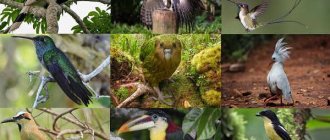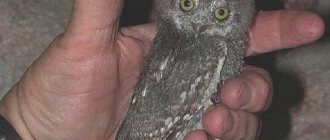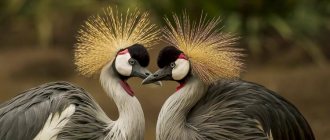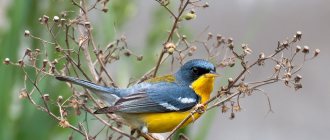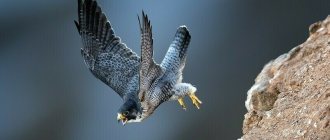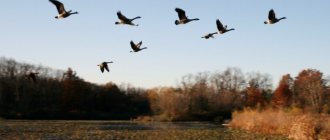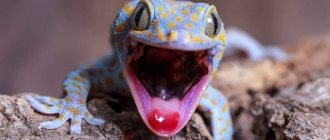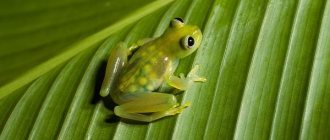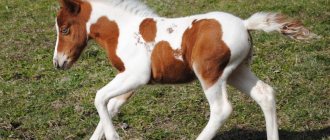Owl - animal or bird, characteristics of the detachment
An owl is a bird, a predator that belongs to the order Owls (Latin name Strigiformes). It is believed that birds similar in description to an owl appeared 10-25 million years ago.
The spotted owl is a bright representative of its family
The order includes more than 200 species of birds belonging to two families:
- barn owls;
- owls (real owls).
Most species are united by a nocturnal lifestyle (with rare exceptions) and a characteristic appearance. Many are found in Russia, for example:
- great gray owl - height 80 cm, inhabits taiga;
- long-eared owl - not large, up to 35 cm, found in coniferous forests;
- little owl - size up to 28 cm, lives in steppes and semi-deserts;
- Great Sparrow Owl – size 15-19 cm, prefers spruce forests;
- white (polar) owl - grows up to 60-65 cm, lives in the Arctic Circle;
- barn owl - size 39-40 cm, inhabits light forests, open plains;
- scops owl (or scops owl) – body length up to 22 cm, found in the mountains;
- eagle owl - height from 60 to 75 cm, lives in any landscape if there is shelter;
- hawk owl - size 35-45 cm, inhabits coniferous and mixed forests.
This is a short list; there are 17 species in the Russian Federation. As you can see, owls live wherever food can be found: in hot regions and permafrost zones, in mountains and forest thickets, in wild areas and near people.
In desert areas, birds nest and hide from the sun among stones
What does an owl look like
When talking about owls, they invariably note their large, densely feathered head. The eyes are round, large, located in front and shifted towards the middle, towards the beak. However, they are motionless. To look around, the bird turns its entire head, and the turn range is from 180 to 270 degrees. The angle of view with the normal position of the head is 160 degrees.
This is interesting! The owl's eye is not spherical, but elongated. The lens is located in the horn tube, and not in the eyeball itself, thanks to which the bird sees in the dark and in bright light.
The ears of owls are unusually sensitive; here they are superior even to those of cats. Birds have an outer ear, which is surrounded by a fold of skin and feathers. It allows you to capture the slightest sound vibrations.
The tail is rounded and short with curved tail feathers. The wingspan, depending on the size of the bird, reaches 2 m. The beak is short, with a bend coming from the base, ending in a hook. The cere is covered with short feathers. The owl's legs are quite long and feathered. They are strong and tenacious to catch prey from the air. Large, thick claws curved inward allow them to hold food tightly.
Worth knowing! The smallest are elf owls, their size is only 13 cm, weight - 31 g. The largest are fish and eagle owls, their body length is more than 70 cm, and weight - 4.2 kg.
It is difficult to determine by eye whether a particular owl is a male or a female. Girls are usually larger, but not in all species. The color of owls is camouflage and practically does not differ by gender.
"Camouflage" allows you to avoid enemies and get close to victims
What color an owl is depends on the area in which the species lives. General color trends:
- discreet, calm tones;
- predominance of gray, brown and yellow tones;
- small black speckles, spots or stripes scattered over the body.
Particularly beautiful species of owls:
- polar – snow-white with black spots;
- Nepalese eagle owl - grayish plumage and a pattern on the chest that looks like hearts;
- barn owl - bright brownish-red feathers on the wings, back and head;
- neotropical – white bird with a black “mask”.
Birds
Predator birds. Owl
Strigiformes - Birds of prey at night.
Owls
- a group of birds belonging to the order
Owls
, consists of 200 species of extant birds of prey.
Most are solitary and nocturnal, with a few exceptions (eg Northern Hawk Owl). Owls hunt primarily small mammals, insects, and other birds, although a few species specialize in hunting fish. They are found in all regions of the Earth, with the exception of Antarctica, most of them in Greenland and some remote islands. The owl has a small beak on a broad face, and is divided into two families: the owls (typical owls) and the barn owls (Tytonidae). Anatomy of an owl.
Predator birds. Full face of an owl
Owls have a flat and wide face, eyes and ear openings at the front, a hawk-like beak, and usually a prominent circle of feathers around each eye. The facial feathers can be adjusted to sharply focus on sounds that come from different distances to the owl's asymmetrically placed ear cavities. Most birds of prey have eyes located on the sides of the head, but the stereoscopic nature of the owl's face has the eyes placed forward for greater depth perception needed for night hunting. Although owls have binocular vision, their large eyes are in sockets like all birds, so they must turn their entire head to change the direction of their gaze. Although owls have very good vision, they are unable to clearly see anything a few centimeters from their eyes. The owl can sense caught prey using feathers on its beak and legs, which act as “tentacles.”
Predator birds. Turning the owl's head
An owl can use its neck to turn its head 270 degrees (135 degrees in any direction). Owls have fourteen cervical vertebrae, compared to 7 in humans, making their necks more flexible. They also have a unique feature in their cardiovascular system that allows rotation of the head without cutting off blood flow to the brain. They have holes in their spine through which arteries pass.
The smallest owl weighs 31 grams (1 oz) and stands about 13.5 cm (5 inches) tall - the Elf Owl or Cactus Owl. At its smallest stature, it is slightly heavier than the Tamaulipas pygmy owl. The largest owl is the Great Gray Owl, which reaches about 70 cm (28 in) in length on average and can reach a length of 84 cm (33 in). However, the largest (and largest winged) large owls of similar size are the Eurasian Eagle Owl and the Blakiston (Fish Owl). These two species, which average 2.53 cm (1.00) shorter in length than the Great Gray Owl, can both achieve a wingspan of 2 m (6.6 ft) and weigh 4.5 kg (10 lb).
The cry of an owl is very unique. Owls produce a wide range of sounds in search of partners and, announcing their presence to potential competitors.
Owl plumage is typically cryptic, with many species having head markings including face masks, ear tufts and brightly colored irises. These markings tend to be more common among species that live in open environments and are thought to be used to signal others in low light conditions.
Breeding and reproduction of owls.
owl chicks and eggs
Females lay hard amniotic eggs. Owl eggs are typically white in color and nearly spherical in shape, and are laid ranging from a few to dozens, depending on the species and particularly the time, with three or four being the most common number for most. The eggs are laid in 1 to 3 days and do not hatch in the meantime. The owl, unlike many birds, does not build nests. Instead, it uses nests built by other species in previous seasons, or makes its home in tree holes, cracks, or depressions in the ground.
Behavior.
primarily nocturnal hunters , actively pursuing prey only in the dark. Several types of owls, however, are active during the dusk and dawn hours, one example being the Pygmy Owl. A few owls are also active during the day, examples being the Great Owl and the Short-eared Owl.
The owl's sharply angled front flight feathers reduce noise levels. Owl eyes can move independently of each other.
The success of an owl's hunt depends on a strategy of stealth and surprise. Owls have at least two personalities that help them achieve stealth. Firstly, the coloration of their feathers can make them almost invisible under certain conditions. Secondly, the jagged, sharp-angled edges of owl feathers allow them to be virtually silent.
The owl has a sharp beak and powerful talons allowing it to kill its prey before swallowing it whole (if it is not too large). Scientists studying the diet of owls have noticed their habit of regurgitating indigestible elements of their prey (such as bones, scales and fur) in the form of pellets. These "owl pellets" are abundant and easy to interpret, and are often sold by companies to schools for student dissection, biology and environmental science classes.
Adaptations for hunting among owls.
Predator birds. Owl attack
All owls are carnivorous birds of prey, and primarily live on a diet of insects and small rodents such as mice, rats and hares. Several owls are also specially adapted for hunting fish. They are very adept at hunting in their respective environments. Owls can be found in almost all parts of the world and in a variety of ecosystems and locations, and their hunting skills and characteristics vary slightly from species to species, although most characteristics are common to all species.
Flight and feathers of an owl.
Owl feathers
Most owls have the innate ability to fly almost silently and also more slowly than other birds of prey . Most owls are primarily nocturnal and their ability to fly undisturbed gives them a serious advantage over their prey without making any sign of noise in the dark of night. Quiet, slow flight is not necessary for the diurnal and crepuscular owl, given that prey can usually see the owl approaching. While the morphological and biological mechanisms of this silent flight are more or less known, the structure of the feather has been intensively studied in large part by accredited structures as to why they have this ability. Owl feathers tend to have smooth edges with a variety of textures. Serrated edges along the wing, almost silent mechanism. Research has shown that sharply angled seatstays are more likely to reduce aerodynamic disturbances rather than simply reduce noise. Surface of flight feathers: covered with a velvety structure that absorbs the sound of the moving wing. These unique structures reduce the noise level at frequencies above 2 kHz, the volume of the sound signal falls below the typical auditory spectrum of owl prey and also improves its own auditory range.
Owl vision.
Another characteristic is their vision. Owls are part of a small group of birds that are nocturnal but do not use echolocation to guide their flight in low-light conditions. They are known to have disproportionately large eyes compared to their skull. An obvious consequence of the evolution of absolutely large eyes in a relatively small skull is that the eyes have become tubular in shape. This form is found in other so-called nocturnal eyes, such as the eyes of prosimians and the bati of pelagic fish. Because the eyes are tubular in shape, they cannot move in any direction. Instead of moving the eyes, turn the head to visualize their surroundings. The head's turning radius is about 270 degrees, easily allowing them to see what's behind them without moving their body. This feature keeps bodily movement to a minimum, and thus reduces the amount of sound as it awaits its prey. Frontally placed eyes give them a binocular field of vision. They are far-sighted and cannot focus on an object a few centimeters from their eyes. While owls are thought to have night vision due to their large (and thus very light-gathering) eyes and/or extremely sensitive receptors, the real reason for their ability to see at night is neural mechanisms that mediate spatial information. collected from vision over the entire night-time brightness range. These mechanisms are able to function only due to the large size of the visual organs.
Owl hearing.
Owls have specialized hearing, a function based on the shape of the ear, which also helps in hunting. As already noted, there is an asymmetrical placement of the ears on the skull in some genera. May have either internal or external ears, but in these genera only the external placement of the ears exhibits asymmetrical ear geometry. the owl's middle or inner ear . The asymmetrical placement of the ears on the owl's skull allows it to determine the location of its prey. This is especially true for strictly nocturnal owl species. With ears located at different places in its skull, it distinguishes the owl by being able to determine the direction from which a sound is coming out in one minute, the difference in the time it takes for sound waves to reach the left and right ear. The owl turns its head until the sound reaches both ears, at which point it directly faces the source of the sound. This time the difference between the ears is approximately 0.00003 seconds, or 30 millionths of a second. In coordination with this left-to-right calibration, several owls (such as the barn owl) have slight up-down asymmetries in their ears, which allows the owls to determine whether a sound is coming higher or lower in vertical space by the volume of the sound in each ear. If the sound is louder in the upper ear, the prey is taller than the owl. Just like the eyes, which use feathers to focus light, the ears are surrounded by feathers to maximize hearing capabilities. The facial disc itself directs sound to the ears, while the sharply triangular beak minimizes reflections of sound from the face. The shape of the face disc is adjusted at will, focusing sound more effectively. They have an audible range similar to humans, but much more acutely at certain frequencies, allowing them to detect even the slightest movement of their prey. After the owl locates its prey, it flies towards it on the last sound it senses. If the prey moves, this gives them the opportunity to adjust their flight mid-flight.
Owl claws.
Owl claws
While the auditory and visual capabilities enable it to detect and pursue its prey, the owl's talons and beak do the final work. The owl kills its prey by using these talons to crush the skull and crush the body. The owl varies the crushing power of its talons depending on the type of prey and size. Burrowing Owls (Athena cunicularia), a small subset of insectivorous owls, have a release force of only 5 N. The Great Barn Owl has a force requirement of 30 N to not let go of its prey, and one of the largest owls, the Great Eagle Owl (Bubo virginianus) has a force requirement of more than 130 N to hold prey in its claws. The owl's talons , like those of most other birds of prey , can appear massive in relation to their body size when not in flight. Differ from diurnal birds of prey because two toes point forward and two toes point backward when perched. During flight, three of the four fingers face forward. The talons of several owls are adapted to include feathers that help them catch small prey at night. The lower part of the claws, legs are covered with rough, knobby surfaces, allowing it to grab its prey and hold it without having to keep the muscles tightly clenched. The barn owl family has an inner and central toe that are approximately the same length, and the owl family has an inner toe that is clearly shorter than the central one. These different morphologies allow them to effectively capture prey specific to their different habitats.
Owl beak.
Owl beak
The owl's beak is short, curved downward, and typically protrudes at the tip for capturing and tearing prey. When the victim is captured, movements of the upper and lower jaw are used to tear tissue and kill. The sharp lower edge of the upper jaw works in coordination with the sharp upper edge of the lower jaw. Moving the beak down and forward gives the owl a clearer field of vision while also directing sound into the ears, directing the sound waves away from the face.
Camouflage, coloring.
The coloration of an owl's plumage plays a key role in its ability to sit and blend into its surroundings, making it nearly invisible to prey. Owls tend to imitate the colors and sometimes even the textures of their surroundings; the barn owl is an exception. Nyctea scandiaca, or Snowy Owl , is very white with occasional black flecks, blending beautifully with its snowy surroundings. Also, the Tree Owl (Strix ocellata) displays shades of brown, beige and black, making the owl nearly invisible in tree canopies, especially from behind.
Evolution and systematics.
There are 220-225 living species of owls, which are divided into two families: the typical owl (Strigidae) and the barn owl (Tytonidae). Some completely extinct families have been reconstructed from fossil remains. They differ from modern owls by being less specialized or specializing very differently (like the terrestrial Sophiornithidae). The Paleogene genera Berruornis and Ogygoptynx show that owls were already present as a separate lineage around 60-57 million years ago, and therefore possibly also around 5 million years ago, with the extinction of the dinosaurs. This makes them one of the oldest known groups of Galloanserae landbirds. The supposed " Chalk owls " Bradycneme and Heptasteornis are apparently non-avialan maniraptors.
Around the Paleogene-Neogene boundary, the barn owl was the dominant group of owls in southern Europe and adjacent Asia at least; the distribution line of fossil and modern owls indicates that their decline is contemporary with the development of various major lineages of type owls, which for the most part appears to have taken place in Eurasia. In America, there was a fairly extensive immigration of the ancestral line of the typical owl.
Ancient fossil owls.
For fossil species and paleosubspecies extant taxa.
Aegolius - Great-footed owls Berruornis (Late Paleogene, France) Palaeoglaux (Middle - Late Eocene, Europe) Palaeobyas (Late Eocene/Early Oligocene from Quercy, France) Palaeotyto (Late Eocene/Early Oligocene from Quercy, France) Owls gen. et Dissostichus indet. (Early Oligocene Wyoming, USA) Ogygoptynx (Mid/Late Paleogene Colorado, USA) Eostrix (Early Eocene WC-USA - Middle Eocene WC USA) Minerva (Middle - Late Eocene W USA), formerly Protostrix, includes " Aquila" ferox, "Aquila" lydekkeri, and "Bubu" leptosteus Oligostrix (mid-Pleistocene Saxony, Germany) Sophiornithidae Sophiornis Tytonidae: ancient Barn Owls Barn Owl (Alba Apartments)
The Barn Owl genus is a typical old barn owl, up to 500 mm in height. About 15 species, and perhaps one recently extinct.
Genus Barn owls - bay owls , 1-2 living species and possibly one recently extinct.
Fossils of the genus:
Nocturnavis (Late Eocene/Early Oligocene) includes "Buba"; Selenornis (Late Eocene/Early Oligocene) - includes "Asio"; Necrobyas (Late Eocene/Early Oligocene - Late Miocene) includes 'Buba' arvernensis and Paratyto; Prosybris (Early Miocene);
Posted Unsolved:
Tytonidae gen. et sp. indet. "TMT 164" (Middle Miocene); Strigidae: Typical owls; Long-eared Owl (Asio otus) in an erect pose; Laughing Owl (Sceloglaux albifacies), last seen 1914; Owl - saw teal owls, four species; Asio - long-eared owls, 67 species; Athena - 2-4 species (depending on whether Speotyto and Heteroglaux are included or not); Eagle owls - Bubo - horned owls; paraphyletic with Nyctea, Pisces, and Scotopelia, about 25 species; Ciccaba - four species; Glaucidium - Sparrow owls, about 30-35 species; Grallistrix - owl stilts, four species; prehistoric; Gymnoglaux - Bare-footed Owl or Cuban Screech-Owl; Jubula - Maned Owl; Lophostrix - Great Horned Owl; Mascarenotus - Mascarene owls, three species; Megascops - screech owl, about 20 species; Micrathene - Elf Owl; Mimizuku - Giant Owl - Owl or Mindanao Eagle Owl; Ninox - Needle-footed owls, about 20 species; Nesasio - Solomon long-eared owl; Ornimegalonyx - Ornimegalonyx (Caribbean giant owls), 1-2 species; prehistoric; Otus - common cutworm - owl; probably paraphyletic, about 45 species; Pseudoscops - Jamaican Owl and possibly Barred Owl; Ptilopsis - pallid owls, two species; Pulsatrix - Neotropical owls, three species; Pyrroglaux - Palau Owl; Sceloglaux - Laughing Owl; extinct (1914); Strix - Tawny Owl, about 15 species; Surnia - Northern Hawk Owl; Uroglaux - Papuan Hawk-owl; Xenoglaux - Long Whiskered Owlet Mioglaux (Late Oligocene? - Early Miocene WC Europe) - includes "Bubu" poirreiri; Intutula (Early/Middle ?Late Miocene C Europe) - includes "Strix/Ninox" brevis; Alasio (Middle Miocene Vieux-Collonges, France) - includes "Strix" collongensis; Oraristrix (Late Pleistocene)
Placements remaining unresolved:
"Otus/Strix" wintershofensis: fossil (Early/Mid Miocene from Wintershof West, Germany) - may be close to the extant genus Ninox; "Strix" edwardsi – fossil (Mid/Late Miocene); “Asio” harmfulness – fossil (At the beginning of the Pliocene Odessa, Ukraine); Ibiza Owl, Strigidae gen. et sp. indet. – prehistoric;
Symbolism and mythology.
Africa
Among the Kikuyu of Kenya, owls were believed to be harbingers of death. If anyone saw an owl or heard its cry, someone had to die. In general, owls are seen as harbingers of bad luck, illness, or death. The faith is still widespread today.
America
In the culture of the Uto-Aztec tribe, the Hopi, owls are associated with magic and other vices. The Aztecs and Mayans, along with other people from Mesoamerica, considered owls to be a symbol of death and destruction. In fact, the Aztec God of Death, Mictlantecuhtli, was often depicted with an owl . There is an old saying - in Mexico - that is still used: cuando El tecolote canta, El indio muere ("When the owl hoots and sings, the Indian dies"). In Mayan Religious text, the owl is described as the messenger of Xibalba (Mayan "Place of Fear"). The belief that owls are messengers and harbingers of dark forces is also found among the Hočągara (Winnebago) of Wisconsin. When in former times, Hočągara committed the sin of killing enemies while they were in the sanctuary of the main s lodge, an owl appeared and spoke to them in the voice of a man, saying: "From now on Hočągara will have no luck." This marked the beginning of their tribe's decline. People often point to the owl's reputation as a bearer of supernatural danger. Also, in the Cherokee Native culture, as well as many other Native American cultures, owls are a very bad omen. They say that if you are out in the dark and an owl flies overhead, a family member or loved one will die in the coming weeks.
Near East
In Arabian mythology, owls were seen as a bad omen.
Western culture
Owl - image of protocorinthian aryballos, ca. 640 BC, from Greece. In the modern West, owls are generally associated with wisdom.
Sir William Thiselton-Dyer in his Folklore Shakespeare says that “from the earliest period, the Owl is considered an ominous bird, and Pliny represents it as a bird of mourning, a monster of the night, very vile to the human race. Ovid also constantly talks about this, about the presence of a bird as a bad sign, and indeed, the same concepts about this can be found among the works of most ancient poets. The list of "omens of Pestilence" in John Keats' Hyperion includes "the gloom—the hateful cry of the bird."
In France, Belgium and the Netherlands, where owls are divided into long-eared owls (French hiboux / d. oehoes) and one-eared owls (French chouettes / d. bosuilen), the former are seen as symbols of wisdom, while the latter are given a dark meaning.
In three Canadian provinces, owls are the provincial symbols: Great Eagle Owl in Alberta, Great Gray Owl in Manitoba, and Snowy Owl in Quebec. The population uses owls as a natural predator to control rodents.
All owls are listed in Appendix II of the international treaty (Convention on International Trade in Endangered Species of Wild Fauna and Flora). Although owls have long been hunted, a 2008 report from Malaysia suggests that poaching rates may be on the rise. In November 2008, a traffic hijacking of 900 owls was reported on Peninsular Malaysia.
Localization:
Owls live on every continent except Antarctica. They live all over the world, from dense forests to wide open grasslands. Snowy owls inhabit the tundra, localizing the entire circumpolar zone in the Arctic. Barn owls, the most common of all owl species, are found on every continent around the world and live in temperate forests, tropical forests, coniferous forests and various types of grasslands and savannas. The great eagle owl occupies a wide range that stretches across much of North, Central and South America.
Many tropical owls are endangered due to deforestation and fragmentation of the forests in their locality. Pesticides have also had a negative impact on owl numbers, particularly locally when hazardous chemicals are used to kill rodents. In many cases, we simply don't know enough about species to know that we are affecting their numbers. Owl conservation is becoming increasingly popular, and various conservation groups have begun installing nest boxes to promote breeding. For those species that will use artificial structure, a nest box or platform program may have a positive effect on population size.
Owl video, owl cry
Anatomical structure of an owl
The skeleton of the representatives of the order is such that it gives the birds advantages in survival, given the hunting style and the fact that they are active in the dark. General distinctive features:
- 14 vertebrae for special neck flexibility;
- on the third finger there is a short phalanx;
- there are processes on the main bone;
- there is a depression on the back surface of the sternum (barn owls do not have one);
- the skull and lower jaw have a triple articulation;
- the outer toe may bend backward.
The ear openings are wide, and the front part of the owl's skull is flat, covered with thick soft feathers. This is necessary so that the sound is not distorted by the protrusions of the face, does not reflect from them, but immediately enters the auditory canal.
The owl's neck has an interesting structure. To prevent the vessels from being pinched when turning the head, the carotid arteries are dilated under the lower jaw. There is always a supply in these “reservoirs”. Also, an extensive network of small ones departs from the main large vessels, which also create a reserve.
Sometimes the bird turns its head so that it is not immediately clear where it is up and where it is down.
Another feature of the owl’s skeleton associated with the flexibility of the neck: the openings for the vessels in the vertebrae are 10 times larger than the diameter of the vessels themselves, and the vertebral arteries also communicate with the carotid arteries. Thus, no matter how the bird turns its head, the blood supply to the brain does not suffer.
How do the wings of owls work?
These nocturnal birds fly silently to attack prey unnoticed. The main outer feathers are jagged, fringed, saw-toothed. The third and fourth are the longest in the wing. Thanks to this anatomy, they do not create strong friction with air and tangible sound waves.
The structure of the digestive system in birds
In general, we can say that the digestive system of birds is a hollow tube extending from the beak all the way to the cloaca opening. This tube performs many functions at once, taking in food, secreting juices with enzymes that break down food, absorbing substances, and also removing undigested food debris. However, despite the fact that all birds have the same structure of the digestive system, as well as its functions, there are differences in some details that are associated with feeding habits, as well as with the diet of a particular group of birds.
The structure of the digestive system of birds.
The digestion process begins with food entering the mouth. The majority of birds have salivary glands that secrete saliva that wets the food, and this is where food digestion begins. In some birds, such as swiftlets, the salivary glands secrete a sticky fluid that is used to build nests.
The functions and shape of the tongue, as well as the beak of a bird, depend on the lifestyle of a particular species of bird. The tongue can be used both to hold food in the mouth and to manipulate it in the oral cavity, as well as to taste and feel food.
Hummingbirds and woodpeckers have a very long tongue, which they can protrude far beyond their beak. Some woodpeckers have back-facing barbs at the end of their tongue, thanks to which the bird can pull insects and their larvae located in the bark to the surface. But a hummingbird’s tongue, as a rule, is forked at the end and curled into a tube, which helps suck nectar from flowers.
The hummingbird uses its tongue to extract sweet nectar from flowers.
In pigeons, pheasants, grouse and turkeys, as well as in some other birds, part of the esophagus is constantly enlarged (called the crop) and is used to store food. In many birds, the esophagus is quite distensible and can hold a significant amount of food for some time before it enters the stomach.
The stomach in birds is divided into a glandular and muscular (“navel”) part. The glandular part secretes gastric juice, which breaks down food into substances suitable for subsequent absorption. The muscular part of the stomach is characterized by thick walls and hard internal ridges that grind food, which is obtained from the glandular stomach, which serves a compensatory function for these edentulous animals. The muscle walls are especially thick in those birds that feed on seeds and other solid foods. Since some of the food that has entered the stomach may be undigested (for example, solid parts of insects, hair, feathers, parts of bones, etc.), many birds of prey have rounded, flat pellets formed in the “navel”, which are belched from time to time.
Thanks to the well-coordinated functioning of the digestive system, little chicks grow up and become beautiful birds.
The digestive tract continues with the small intestine, which immediately follows the stomach. This is where the final digestion of food occurs. The large intestine in birds is a thick straight tube leading to the cloaca. In addition to it, the ducts of the genitourinary system also open into the cloaca. As a result, both fecal matter and sperm, eggs and urine enter the cloaca. And all these products leave the bird's body through this one hole.
Where do owls live and nest?
Owls are found in Asia, Africa, and inhabit Europe and both American continents. Where an owl lives, there should be plenty of food, shelter for resting and nesting, so most species prefer forests. They settle in hollows and nests of other birds. Sometimes they settle in caves, abandoned burrows, between rocks, and even in holey walls of human houses. House owls and barn owls often nest in attics, but eagle owls survive in any natural area. Birds avoid artificial nests - owls. Only the great owl is comfortable in them.
This is interesting! The hollow in which the owl lives is unremarkable in appearance, and there is no bedding inside, even if the female has laid eggs.
A hollow is a safe shelter, an observation post, and a home for a family.
Do owls fly away for the winter?
Whether an owl is a wintering bird or a migratory bird depends on the climate. In general, owls do not leave their habitable places. Only one species - the short-eared owl moves to the south with the onset of cold weather. However, in particularly frosty winters, birds can fly long distances in search of shelter and food. They often appear in villages and cities, where it is warmer, there is food waste, and therefore rodents.
But migration is also characteristic of sedentary birds. In autumn, the young fly away to look for their own territory, covering from 100 to 200 km. The bird wanders until it creates a pair.
Keeping at home
You can have an owl as a pet if you are willing to provide the bird with its vital needs. A night hunter will want activity from evening to morning, so the bird will not let its owner sleep.
To feed, owls need whole carcasses of rodents or birds; meat just won’t do. Not every owner will be internally prepared for this. Birds need enough space to not sit in a cage, spread their wings, and sometimes fly. Eagle owls, tawny owls and other large birds are not suitable for keeping in an apartment.
The owl in the photo always attracts attention with its attentive gaze. Owners of tame birds note their intelligence, playfulness, vitality, and curiosity. You should only buy an owlet from a nursery, since the markets often sell individuals caught by poachers.
Wild birds are often unhealthy, so you can bring the infection into the house and be left without a pet. Diseases in birds develop rapidly. Only a competent approach and sincere care will ensure the health and well-being of the owlet.
Lifestyle and habits
We can say that an owl is a creature that is created to hunt. What makes it an ideal predator is its silent flight, sharp eyesight and hearing. An owl is able to hear prey under a thick layer of snow, in water, in a hole, in grass or straw. To lure out a small animal, the bird periodically emits loud, sharp screams. The predator attacks from above, putting its paws forward with powerful claws.
Although the owl is a predominantly nocturnal bird, some species not only sleep during the day, but also hunt:
- little owl;
- White Owl;
- pygmy owl;
- hawk owl.
There is a myth about the behavior of owls, supposedly they form “parliaments” - numerous groups. This is wrong. Owls live and hunt alone (except for married couples).
What do nocturnal birds eat?
The main diet of owls is rodents, and small species are insects. There are species that feed on fish. Sometimes owls attack other birds, but rarely, mainly in winter, when it is difficult to catch other prey. In warm latitudes, the menu is varied with berries and fruits. By the sea - shellfish, crabs.
Worth knowing! Black grouse, wood grouse and even other birds of prey – peregrine falcons and hawks – can become victims of owls.
Size allows eagle owls to hunt large prey
Birds also eat:
- moles;
- toads, frogs;
- lemmings;
- lizards;
- chickens;
- bats;
- shrew;
- snake;
- hedgehogs;
- hares.
Some representatives are stocking up. Thus, owls store mice and other prey in hollows and empty birdhouses.
Thanks to their predatory lifestyle, owls are able to go without drinking for months - they get water from the blood of their victims. However, birds still look for bodies of water to swim.
Long-eared owl on the hunt
Where the owl hunted, in winter you can easily find its tracks. They are most often found along forest edges, forest clearings, at the edges of swamps, near clumps of bushes or thickets of weeds. On a high stump or low horizontal branch 1.5-2 m above the ground, familiar prints of owl paws are visible. At this perch, the owl was waiting for the victim to appear, and returned here with a captured vole.
It is clear that she has been sitting in one place for a long time - all the snow has been trampled by her paws, and creamy white blots of droppings are visible under the perch. Based on the size of the blots, you can determine approximately the size of an owl, if for some reason the bird's paw prints are not visible. Having discovered a vole or mouse jumping out into the snow, the owl rushes at it and, if successful, eats the prey, sitting right there in place or taking it to a perch. By the way, she often carries small prey not in her paws, as the vast majority of diurnal birds of prey do, but in her beak.
At the site where the prey is eaten, the snow is stained with the blood of the victim. Quite often, the intestines and stomach of the animal remain. This contradicts the belief that most owls swallow their prey whole. Sometimes you can also find owl pellets dropped here before eating the prey. Small owls (long-eared, short-eared, owls, etc.) tear the rodent apart and swallow it in large pieces. Sometimes, when there are a lot of rodents and the owl is well-fed, it eats only the head or the front part of the carcass, throwing away the rest. Larger owls, such as the Ural owl, swallow even large voles whole.
In addition to stalking prey from perches, owls very often use search flights, flying at low altitudes around areas rich in rodents. When a victim is detected, the bird falls down with its paws outstretched and its claws straightened. From the tracks left in the snow, it is clear that the predator makes attacks not only on animals that have jumped to the surface, but also on those that are moving through the snow at a shallow depth.
An oval hole remains in this place, pressed down by the paws and body of the bird. On the sides of the hole, traces of wings are visible, and behind them, sometimes, strokes of long tail feathers that have touched the surface of the snow. If the dive was successful, and this happens in about one out of 5 throws, then sometimes traces of blood remain at the bottom of the hole. Such traces are visible from a distance of 3-4 m.
Reproduction and appearance of offspring
The description of an owl as a bird is surprising not only because of its anatomy and habits. The “family life” of birds is a different story. Owls do not reproduce spontaneously. The selection of a partner is careful, because these birds create a couple once and for all (with the exception of a few species). If there is enough food and environmental conditions are favorable, the birds organize a nest in a secluded place and lay eggs. The quantity depends on how comfortable the mother feels: minimum 3, maximum 10 pieces. The interval between the release of the first and last eggs can be several days, so the owl's chicks appear at different times.
Parents take care of the chicks until they can fly well and learn to hunt.
Incubation period is 24-36 days. Only the mother sits in the nest, but the father is always nearby, protecting the family. He flies for food. Owls hatch sluggish, blind, with weak legs, eyes and ears covered with down. They begin to see after 2 weeks. Full-fledged feathers will not appear soon; before that, the loose fluff must be replaced by mesoptile - a secondary cover of harder down.
Worth knowing! If there is not enough food, older owlets and even parents eat younger or weaker chicks.
After 3 weeks, young people try to get out into the big world. The chicks do not yet know how to fly, so their parents take care of them, and the birds themselves do not go far. Sexual maturity among representatives of the owl order occurs at 1 year. The number of ovipositions depends on living conditions. If all is well, there are several of them per year. In case of a lack of food, territory or an abundance of enemies, the birth of offspring occurs only once a year.
Long-eared owl paw prints
Paw prints of an owl sitting on the snow (a); traces of a bird trampling in one place (b) and moving in leaps (c)
The paw prints of the long-eared owl are most often found at the site of hunting or eating prey, as well as on a perch sprinkled with snow. The length of the paw print together with the claws is about 7 cm. By the way, when trying to measure the owl's footprint, we encounter some difficulties.
How to measure? Traditionally, a bird's four-toed paw print is measured from the front mark made by the claw or end of the middle (3rd) toe, and the back mark in the snow from the back (1st) toe. But in an owl, it is not the 3rd (middle) finger that is directed forward, but the 2nd finger, forming a sort of straight line with the back finger. In my opinion, most often in reference books this length is indicated - from the end of the 2nd to the end of the 1st (back) finger. To avoid any confusion, you should always indicate how the owl track was measured. The claws also hinder the accuracy of measurements somewhat. The owl's are long and strongly curved.
Sometimes the bird extends the end of the finger, and then the hole left by the claw appears at a fairly large distance from the end of the finger. Sometimes the owl seems to pick up its claws and they push through the snow or soil right next to the finger. At times, for some reason, the claws are not visible at all on the paw print. In doubtful cases, it is advisable to measure the length of all toes (from the heel to the end of the toe plus the claw).
Natural threats to owls
In nature, they live up to 5 years, or even one season. In captivity or reserves 20-50 years (larger species live longer). Although the owl is a strong bird and is able to defend itself, it is hunted by other large feathered predators, as well as martens. It is typical that the latter attack females, chicks and destroy nests. It happens that a bird is walled up in a hollow on a nuthatch masonry - the hole is covered with clay.
Martens are especially dangerous to chicks and small owls
It’s bad if the environment changes, but this is usually due to humans. Many birds die due to lack of territory, food, or are hit by cars at night.
Family life
Owls are monogamous. Having formed a union with an individual of the opposite sex, they live together almost their entire lives. The offspring during the laying period is up to 10 white eggs in the shape of an almost perfect ball.
Moreover, owls rarely build their own nests, preferring to occupy someone else’s. A month after birth, the chicks begin an independent life, if they are lucky enough not to feed on other birds of prey or on each other during periods of lack of basic food.
